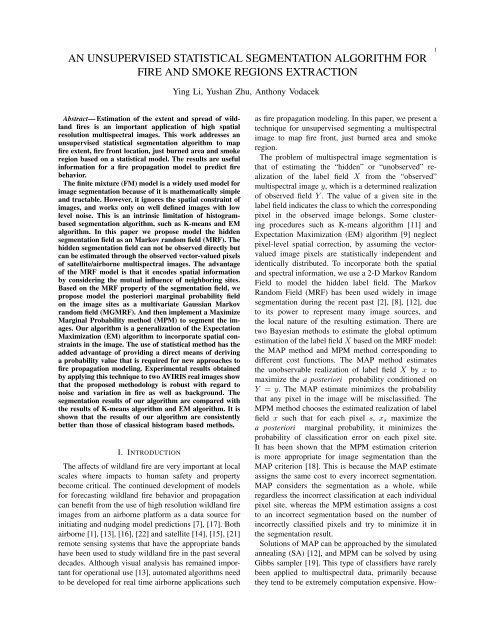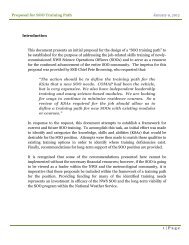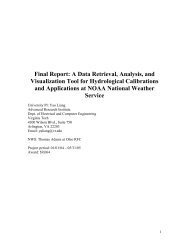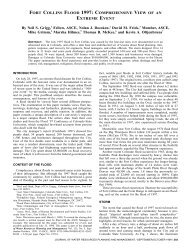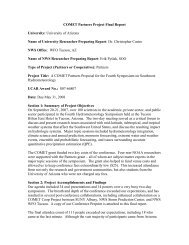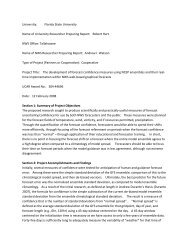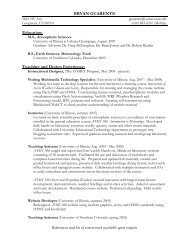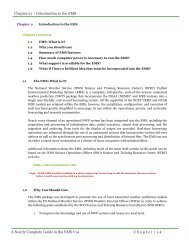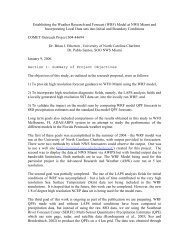an unsupervised statistical segmentation algorithm for fire ... - COMET
an unsupervised statistical segmentation algorithm for fire ... - COMET
an unsupervised statistical segmentation algorithm for fire ... - COMET
Create successful ePaper yourself
Turn your PDF publications into a flip-book with our unique Google optimized e-Paper software.
AN UNSUPERVISED STATISTICAL SEGMENTATION ALGORITHM FOR<br />
FIRE AND SMOKE REGIONS EXTRACTION<br />
1<br />
Ying Li, Yush<strong>an</strong> Zhu, Anthony Vodacek<br />
Abstract— Estimation of the extent <strong>an</strong>d spread of wildl<strong>an</strong>d<br />
<strong>fire</strong>s is <strong>an</strong> import<strong>an</strong>t application of high spatial<br />
resolution multispectral images. This work addresses <strong>an</strong><br />
<strong>unsupervised</strong> <strong>statistical</strong> <strong>segmentation</strong> <strong>algorithm</strong> to map<br />
<strong>fire</strong> extent, <strong>fire</strong> front location, just burned area <strong>an</strong>d smoke<br />
region based on a <strong>statistical</strong> model. The results are useful<br />
in<strong>for</strong>mation <strong>for</strong> a <strong>fire</strong> propagation model to predict <strong>fire</strong><br />
behavior.<br />
The finite mixture (FM) model is a widely used model <strong>for</strong><br />
image <strong>segmentation</strong> because of it is mathematically simple<br />
<strong>an</strong>d tractable. However, it ignores the spatial constraint of<br />
images, <strong>an</strong>d works only on well defined images with low<br />
level noise. This is <strong>an</strong> intrinsic limitation of histogrambased<br />
<strong>segmentation</strong> <strong>algorithm</strong>, such as K-me<strong>an</strong>s <strong>an</strong>d EM<br />
<strong>algorithm</strong>. In this paper we propose model the hidden<br />
<strong>segmentation</strong> field as <strong>an</strong> Markov r<strong>an</strong>dom field (MRF). The<br />
hidden <strong>segmentation</strong> field c<strong>an</strong> not be observed directly but<br />
c<strong>an</strong> be estimated through the observed vector-valued pixels<br />
of satellite/airborne multispectral images. The adv<strong>an</strong>tage<br />
of the MRF model is that it encodes spatial in<strong>for</strong>mation<br />
by considering the mutual influence of neighboring sites.<br />
Based on the MRF property of the <strong>segmentation</strong> field, we<br />
propose model the posteriori marginal probability field<br />
on the image sites as a multivariate Gaussi<strong>an</strong> Markov<br />
r<strong>an</strong>dom field (MGMRF). And then implement a Maximize<br />
Marginal Probability method (MPM) to segment the images.<br />
Our <strong>algorithm</strong> is a generalization of the Expectation<br />
Maximization (EM) <strong>algorithm</strong> to incorporate spatial constraints<br />
in the image. The use of <strong>statistical</strong> method has the<br />
added adv<strong>an</strong>tage of providing a direct me<strong>an</strong>s of deriving<br />
a probability value that is required <strong>for</strong> new approaches to<br />
<strong>fire</strong> propagation modeling. Experimental results obtained<br />
by applying this technique to two AVIRIS real images show<br />
that the proposed methodology is robust with regard to<br />
noise <strong>an</strong>d variation in <strong>fire</strong> as well as background. The<br />
<strong>segmentation</strong> results of our <strong>algorithm</strong> are compared with<br />
the results of K-me<strong>an</strong>s <strong>algorithm</strong> <strong>an</strong>d EM <strong>algorithm</strong>. It is<br />
shown that the results of our <strong>algorithm</strong> are consistently<br />
better th<strong>an</strong> those of classical histogram based methods.<br />
I. INTRODUCTION<br />
The affects of wildl<strong>an</strong>d <strong>fire</strong> are very import<strong>an</strong>t at local<br />
scales where impacts to hum<strong>an</strong> safety <strong>an</strong>d property<br />
become critical. The continued development of models<br />
<strong>for</strong> <strong>for</strong>ecasting wildl<strong>an</strong>d <strong>fire</strong> behavior <strong>an</strong>d propagation<br />
c<strong>an</strong> benefit from the use of high resolution wildl<strong>an</strong>d <strong>fire</strong><br />
images from <strong>an</strong> airborne plat<strong>for</strong>m as a data source <strong>for</strong><br />
initiating <strong>an</strong>d nudging model predictions [7], [17]. Both<br />
airborne [1], [13], [16], [22] <strong>an</strong>d satellite [14], [15], [21]<br />
remote sensing systems that have the appropriate b<strong>an</strong>ds<br />
have been used to study wildl<strong>an</strong>d <strong>fire</strong> in the past several<br />
decades. Although visual <strong>an</strong>alysis has remained import<strong>an</strong>t<br />
<strong>for</strong> operational use [13], automated <strong>algorithm</strong>s need<br />
to be developed <strong>for</strong> real time airborne applications such<br />
as <strong>fire</strong> propagation modeling. In this paper, we present a<br />
technique <strong>for</strong> <strong>unsupervised</strong> segmenting a multispectral<br />
image to map <strong>fire</strong> front, just burned area <strong>an</strong>d smoke<br />
region.<br />
The problem of multispectral image <strong>segmentation</strong> is<br />
that of estimating the “hidden” or “unobserved” realization<br />
of the label field X from the “observed”<br />
multispectral image y, which is a determined realization<br />
of observed field Y . The value of a given site in the<br />
label field indicates the class to which the corresponding<br />
pixel in the observed image belongs. Some clustering<br />
procedures such as K-me<strong>an</strong>s <strong>algorithm</strong> [11] <strong>an</strong>d<br />
Expectation Maximization (EM) <strong>algorithm</strong> [9] neglect<br />
pixel-level spatial correction, by assuming the vectorvalued<br />
image pixels are <strong>statistical</strong>ly independent <strong>an</strong>d<br />
identically distributed. To incorporate both the spatial<br />
<strong>an</strong>d spectral in<strong>for</strong>mation, we use a 2-D Markov R<strong>an</strong>dom<br />
Field to model the hidden label field. The Markov<br />
R<strong>an</strong>dom Field (MRF) has been used widely in image<br />
<strong>segmentation</strong> during the recent past [2], [8], [12], due<br />
to its power to represent m<strong>an</strong>y image sources, <strong>an</strong>d<br />
the local nature of the resulting estimation. There are<br />
two Bayesi<strong>an</strong> methods to estimate the global optimum<br />
estimation of the label field X based on the MRF model:<br />
the MAP method <strong>an</strong>d MPM method corresponding to<br />
different cost functions. The MAP method estimates<br />
the unobservable realization of label field X by x to<br />
maximize the a posteriori probability conditioned on<br />
Y = y. The MAP estimate minimizes the probability<br />
that <strong>an</strong>y pixel in the image will be misclassified. The<br />
MPM method chooses the estimated realization of label<br />
field x such that <strong>for</strong> each pixel s, x s maximize the<br />
a posteriori marginal probability, it minimizes the<br />
probability of classification error on each pixel site.<br />
It has been shown that the MPM estimation criterion<br />
is more appropriate <strong>for</strong> image <strong>segmentation</strong> th<strong>an</strong> the<br />
MAP criterion [18]. This is because the MAP estimate<br />
assigns the same cost to every incorrect <strong>segmentation</strong>.<br />
MAP considers the <strong>segmentation</strong> as a whole, while<br />
regardless the incorrect classification at each individual<br />
pixel site, whereas the MPM estimation assigns a cost<br />
to <strong>an</strong> incorrect <strong>segmentation</strong> based on the number of<br />
incorrectly classified pixels <strong>an</strong>d try to minimize it in<br />
the <strong>segmentation</strong> result.<br />
Solutions of MAP c<strong>an</strong> be approached by the simulated<br />
<strong>an</strong>nealing (SA) [12], <strong>an</strong>d MPM c<strong>an</strong> be solved by using<br />
Gibbs sampler [19]. This type of classifiers have rarely<br />
been applied to multispectral data, primarily because<br />
they tend to be extremely computation expensive. How-
ever, the computation time c<strong>an</strong> be greatly reduced by<br />
archiving local maximum through Besag’s iterated conditional<br />
modes(ICM) [3]. It is reported that the typical<br />
ratios of compute time <strong>for</strong> ICM, Gibbs sampler <strong>an</strong>d SA<br />
are 1:37:6000 [10]. We develop <strong>an</strong> <strong>algorithm</strong> opt <strong>for</strong> <strong>an</strong><br />
<strong>an</strong>alogue ICM to find <strong>an</strong> MPM estimation rather th<strong>an</strong><br />
using Gibbs sampler method. The <strong>segmentation</strong> field<br />
x <strong>an</strong>d the parameters <strong>for</strong> each class are estimated <strong>an</strong>d<br />
updated simult<strong>an</strong>eously. In order to use the ICM method<br />
to find MPM estimation of the “hidden” label field X,<br />
we model the posteriori marginal probability field as a<br />
multivariate Gaussi<strong>an</strong> Markov field.<br />
Our approach separates the pixels in the multispectral<br />
image into regions based on both their spectral <strong>an</strong>d<br />
spatial in<strong>for</strong>mation using MRF model. Since we are<br />
trying to extract <strong>fire</strong> regions including <strong>fire</strong> front, just<br />
burned area <strong>an</strong>d smoke, which have relatively smooth<br />
surface <strong>an</strong>d no texture, we assume we work on images<br />
of objects with smooth surface. In addition, we c<strong>an</strong><br />
consider the textured terrain types to be noise, which<br />
is characterized by the covari<strong>an</strong>ce matrix. Thus the<br />
image c<strong>an</strong> be modeled as a mixture of Gaussi<strong>an</strong> with<br />
spatial constraints. The technique proposed here c<strong>an</strong> be<br />
regarded as a generalization of the EM <strong>algorithm</strong> with<br />
modifications to include the spatial constraints. The spatial<br />
constraint is introduced by modeling the label field<br />
as a Markov R<strong>an</strong>dom Field. The experimental results<br />
on real AVIRIS images indicates that the per<strong>for</strong>m<strong>an</strong>ce<br />
of our <strong>algorithm</strong> is clearly superior to the K-me<strong>an</strong>s<br />
clustering <strong>algorithm</strong> <strong>an</strong>d the EM <strong>algorithm</strong> <strong>for</strong> retrieval<br />
of the <strong>fire</strong> front, just burned area <strong>an</strong>d smoke region in<br />
multispectral images.<br />
The org<strong>an</strong>ization of the paper is as follows. In the<br />
Section II, we briefly recall the Markov R<strong>an</strong>dom Field<br />
model <strong>for</strong> the label field of images we opt. The <strong>algorithm</strong><br />
is described in detail in Section III. The feature set<br />
selected <strong>for</strong> the implication is described in Section IV.<br />
The Section V shows some results of the <strong>unsupervised</strong><br />
<strong>segmentation</strong> <strong>algorithm</strong> on two real images. The paper’s<br />
conclusions are summarized in Section VI.<br />
II. STATISTICAL MODEL<br />
In this paper, we use upper case letters <strong>for</strong> r<strong>an</strong>dom<br />
qu<strong>an</strong>tities/field <strong>an</strong>d lower case letters <strong>for</strong> their deterministic<br />
realizations. We assume that the “observed” image<br />
Y is a r<strong>an</strong>dom field defined on a rect<strong>an</strong>gular grid, S,<br />
of N points, <strong>an</strong>d the vector-value spectral of a pixel at<br />
location s ∈ S is denoted by Y s . Y s takes values in<br />
R d , where d is the b<strong>an</strong>d number of the multispectral<br />
image. X = (X s ) s∈S denote the “hidden” label field,<br />
which contains the classification of each pixel in Y .<br />
Sites in X will take values in the set {1, ..., M}, where<br />
M is the number of classes. Given x s = l, y s follows<br />
a conditional probability distribution <strong>an</strong>d is conditional<br />
independent.<br />
p(y s |l) = f(y s ; θ(l)) (1)<br />
where, θ(l) is the set of parameters of class l. For<br />
all classes, the conditional probability density function<br />
family f(·; θ l ) has the same known <strong>an</strong>alytic <strong>for</strong>m.<br />
The conditional probability density of Y given X c<strong>an</strong><br />
be assumed to exist <strong>an</strong>d strictly positive. Using this<br />
framework, the image may be segmented by estimating<br />
the label field X given the observed image Y .<br />
A. Finite Mixture of Gaussi<strong>an</strong> Model<br />
In the finite mixture of Gaussi<strong>an</strong> model (MoG), <strong>for</strong><br />
a given class l ∈ {1, ..., M} <strong>an</strong>d s ∈ S, the r<strong>an</strong>dom<br />
variables y are independent samples from a multivariate<br />
Gaussi<strong>an</strong> distribution, with the probability<br />
f(y s ; θ(l))<br />
=<br />
1<br />
(2π) d/2 |Σ l | 1/2 exp [ − 1 2 (y s − µ l ) T Σ −1<br />
l<br />
(y s − µ l ) ] (2)<br />
where µ l <strong>an</strong>d Σ l are the me<strong>an</strong> <strong>an</strong>d the covari<strong>an</strong>ce<br />
of class l, respectively. For every class l, p(X s =<br />
l) = α l is mutually independent <strong>an</strong>d called a mixing<br />
parameter. We denote the model parameter set by Θ,<br />
Θ = {α l , µ l , Σ l }. Then the joint probability of x <strong>an</strong>d y<br />
c<strong>an</strong> be calculated given the model parameters<br />
p(x, y|Θ) = ∏ s∈S<br />
p(y s , x s |Θ)<br />
= ∏ s∈S{α xs · f(y s ; θ xs )}<br />
2<br />
(3)<br />
Although this MoG model has been used widely, it<br />
is not considered to be a complete model in practice<br />
because it neglects the spatial in<strong>for</strong>mation by assuming<br />
the vector-valued image pixels to be <strong>statistical</strong>ly independent<br />
<strong>an</strong>d identically distributed. In order to model<br />
the spatial correlation of vector-valued image pixels, we<br />
adopt the Gauss Markov r<strong>an</strong>dom field (GMRF) model in<br />
this paper. And the spectral in<strong>for</strong>mation is incorporated<br />
by adopting the Multivariate Gaussi<strong>an</strong> model <strong>for</strong> <strong>an</strong><br />
image pixel y s , given a specified classification x s , while<br />
the spatial correlation is encoded by modeling the label<br />
field X as <strong>an</strong> MRF.<br />
B. Markov R<strong>an</strong>dom Field Model<br />
The aim of the <strong>segmentation</strong> <strong>algorithm</strong> is to classify<br />
the multispectral images from two imperfect (spectral<br />
<strong>an</strong>d spatial) sources of in<strong>for</strong>mation. The first is that<br />
associated with each pixel s, the vector-valued Y s obey a<br />
known <strong>statistical</strong> distribution given its class(label). It is<br />
assumed that given <strong>an</strong>y particular configuration x ∈ X,<br />
each vector-valued pixel follow a multivariate Gaussi<strong>an</strong><br />
distribution y s |x s , θ xs ∼ N(µ xs , Σ xs ), where θ xs are<br />
the involved parameters. In this paper, N(µ, Σ) denotes
univariate/multivariate Gaussi<strong>an</strong> distribution, with me<strong>an</strong><br />
µ <strong>an</strong>d vari<strong>an</strong>ce/covari<strong>an</strong>ce Σ. The second states that<br />
adjacent pixels tend to from the same class (i.e. have<br />
the same label). It is desirable to construct a r<strong>an</strong>dom<br />
field model to qu<strong>an</strong>tify the second source probabilistically.<br />
MRF theory provides a convenient <strong>an</strong>d consistent<br />
way to model context-dependent entities such as image<br />
pixels <strong>an</strong>d correlated features. This is achieved by<br />
characterizing mutual influences among such entities<br />
using conditional MRF distributions.<br />
In <strong>an</strong> MRF, the sites in S are related to one <strong>an</strong>other<br />
via a neighborhood system. The conditional distribution<br />
of a site in the field given all other sites in the field is<br />
identical to the conditional distribution of the site given<br />
only those sites in a finite symmetric neighborhood<br />
surrounding the site. The neighborhood of a pixel site<br />
s ∈ S is a set of sites N s ⊂ S with the two properties<br />
that ∀s, r ∈ S, s ∈ N r ⇔ r ∈ N s , <strong>an</strong>d s is not in N s .<br />
In this application, we use <strong>an</strong> 8-point neighborhood.<br />
p(x s |x q , all q ≠ s) = p(x s |x q , q ∈ N s ) (4)<br />
In this application, we model the label field X =<br />
X s , s ∈ S as <strong>an</strong> underlying MRF field. The label field<br />
X assumes values in a finite state space {1, 2, ..., M},<br />
which is unobservable. According to the locally dependent<br />
property of MRF field, we assume<br />
p(x s |y) ∼ = p(x s |y λs ) (5)<br />
where λs contains pixel s <strong>an</strong>d its neighbors. For inst<strong>an</strong>ce,<br />
in this paper we use a eight-pixel neighborhood,<br />
then λs is a 3 × 3 block centered on pixel site s. In<br />
addition, we propose using a Gaussi<strong>an</strong> Markov R<strong>an</strong>dom<br />
Field (GMRF) to model the posteriori marginal<br />
probability field given y, which is denoted by Π =<br />
(p(x s |y λs , Θ)) s∈S . Π contains the posterior marginal<br />
probability p(x s |y λs , Θ) <strong>for</strong> each pixel s in Y . It should<br />
be noticed that the r<strong>an</strong>dom field Π is a multivariate<br />
GMRF (MGMRF). The posteriori marginal probabilities<br />
{p(x s = l|y λs , Θ)} l∈{0,1,...,M} at each pixel site s<br />
c<strong>an</strong> be treated as a vector-valued feature on the twodimensional<br />
lattice S. Since the label field X in this<br />
application has unordered labels, the conditional odds of<br />
x s , in favor of class l, depend only on the same-labeled<br />
neighbors [6]. The MGMRF field c<strong>an</strong> be simplified into<br />
M independent Gauss Markov R<strong>an</strong>dom Fields Π l . The<br />
value of Π l at location s ∈ S is the marginal probability<br />
of x s = l given y λs . Thus, Π l,s takes continuous values<br />
in [0, 1]. The MRF property of the GMRF model states<br />
that the posteriori marginal probability π l,s = p(x s =<br />
l|y λs , Θ) is only depend on its neighbors π l,r = p(x r =<br />
l|y Nr , Θ), r ∈ N s . And Π l,s has conditional densities<br />
[4], [5]<br />
p(π l,s |π l,Ns ) ∝ exp{− 1 (π l,s − ∑ β sr π l,r ) 2 }, (6)<br />
2λ s<br />
r≠s<br />
where β sr = 0 unless s <strong>an</strong>d r are neighbors, <strong>an</strong>d<br />
β sr λ r = β rs λ s . λ <strong>an</strong>d β are unknown parameters.<br />
III. SEGMENTATION ALGORITHM<br />
In this section, we describe the <strong>unsupervised</strong> <strong>statistical</strong><br />
<strong>segmentation</strong> <strong>algorithm</strong> <strong>for</strong> estimating the distribution of<br />
regions x. The image may be segmented by estimating<br />
the pixel classifications X, given the observed image Y<br />
<strong>an</strong>d distribution parameters Θ. In particular, we adopt<br />
the maximization the posteriori marginal probability<br />
(MPM) estimation.<br />
We described the MPM <strong>algorithm</strong> in the follow assuming<br />
that Θ is known. The criterion used <strong>for</strong> MPM<br />
is to minimize the expected value of the number of<br />
misclassified nodes in the rect<strong>an</strong>gle lattice. The <strong>segmentation</strong><br />
problem is <strong>for</strong>mulated as <strong>an</strong> optimization<br />
problem, which c<strong>an</strong> be viewed as the minimization<br />
of the conditional expected value of a cost function<br />
R(x ∗ , x) given the observed image Y <strong>an</strong>d parameters<br />
Θ, over all possible realization of the label field X.<br />
The cost function is given by<br />
R(x ∗ , x) =<br />
3<br />
N∑<br />
t(x ∗ s, x s ) (7)<br />
s=1<br />
where, t(x r , x s ) equal 0 when x s ≠ x r , <strong>an</strong>d 1 when<br />
x s = x r . x ∗ is the true value of X. The cost function<br />
R(x ∗ , x) is the number of pixel sites where the estimated<br />
x are different from the true value x ∗ , i.e. the<br />
number of misclassified pixel sites in S.<br />
N∑<br />
E[(R(x ∗ , x)|Y = y] = E[ t(x ∗ s, s s )|Y = y]<br />
=<br />
=<br />
=<br />
s=1<br />
N∑<br />
E[t(x ∗ s, x s )|y = y]<br />
s=1<br />
N∑<br />
p(x ∗ s ≠ x s |Y = y)<br />
s=1<br />
N∑<br />
(1 − p(x ∗ s = x s |Y = y))<br />
s=1<br />
(8)<br />
To find the MPM estimate of x ∗ , it is necessary to find<br />
<strong>for</strong> each s ∈ S the value of l which maximizes the<br />
posteriori marginal probability of x s at s given y<br />
p(x s = l|y) =<br />
∑<br />
p X|Y (x|y, θ) (9)<br />
X:x s =l<br />
where, l ∈ 1, 2, ..., M. Note that p(x s |y) depends on<br />
all pixels to calculate almost all p(x) <strong>an</strong>d is computationally<br />
infeasible. A feasible local method estimate the<br />
realization of each x s by maximize p(x s |y λs ). Even <strong>for</strong><br />
local method, the computation dem<strong>an</strong>d is still enormous.<br />
For inst<strong>an</strong>ce, if there are six classes <strong>an</strong>d we w<strong>an</strong>t to use<br />
a neighborhood containing eight pixels, we have already<br />
a mixture of 6 9 distributions.
In this paper, we adopt iterated conditional modes<br />
(ICM) method to estimate ˆπ l,s = ˆp(x s = l|y λs , Θ),<br />
<strong>an</strong>d then assign ˆx s with l, l = max l (ˆp(x s = l)|y λs , Θ).<br />
We use ˆπ l denotes a provisional estimation of the true<br />
π ∗ l , ICM merely replaces sites in π l with a value which<br />
maximizes the conditional density function, as shown<br />
in Equation 10, at each site s.<br />
p(π l,s |π l,r , r ∈ N s ) (10)<br />
And then choose the label which has maximum conditional<br />
probability given the neighbors π l,Ns . The<br />
r<strong>an</strong>dom field Π l has continuous intensities. It follows<br />
from Equation 6 that<br />
π l,s |π l,Ns ∼ N( ∑ r<br />
γ sr π l,r , λ s ). (11)<br />
Then the estimate ˆπ l of the true value πl ∗ is chosen<br />
to maximize the expectation of Π l . Specifically, the<br />
updating <strong>for</strong>mula at pixel s is a linear combination<br />
of π l,s <strong>an</strong>d the current estimate at neighboring pixel<br />
sites [6]:<br />
ˆπ l,s = (α l π l,s + ∑<br />
γ srˆπ l,r ) (12)<br />
r∈N s<br />
α <strong>an</strong>d γ rs are parameters of the Gaussi<strong>an</strong> Markov r<strong>an</strong>dom<br />
field.The bigger the value of the parameter α l , the<br />
more likely the pixel site x s is belong to class l. Raising<br />
the value of γ has the effect of increasing regions’ size<br />
<strong>an</strong>d smoothing their boundaries. In addition, the value<br />
of different γ rs determine the shape of the regions.<br />
Estimation of these parameters is difficult <strong>an</strong>d computationally<br />
expensive. Besag [6] states that estimation of<br />
these parameter is unnecessary in applications. We use<br />
fixed values of α <strong>an</strong>d γ in this application. Besides the<br />
parameters, the size of neighborhood also has influence<br />
on the shape <strong>an</strong>d size of the segmented regions. The bigger<br />
the neighborhood is chosen, the larger <strong>an</strong>d smoother<br />
the regions will be. In this application, we are trying to<br />
segment the satellite or airborne images into regions<br />
of <strong>fire</strong> front, just burned area, smoke, <strong>an</strong>d background.<br />
These regions usually exp<strong>an</strong>d over a considerable large<br />
group of pixels, so there should not have small isolated<br />
regions in the segmented images. Especially <strong>for</strong> the<br />
background class, it may consists of different terrain<br />
types, i.e. road, river, <strong>for</strong>est, soil, <strong>an</strong>d so on. In order<br />
to classify all these into the same class, i.e. background<br />
class, strong spatial constrain is needed to deal with<br />
this problem. We choose <strong>an</strong> eight-pixel neighborhood<br />
system. Experiments show that the value of γ does not<br />
obviously affect the <strong>segmentation</strong> results, we choose a<br />
value of 1.5 in this application. The value is seems<br />
to work well on discrete MRF field cases in <strong>for</strong>mer<br />
works [6] [20].<br />
The <strong>algorithm</strong> <strong>for</strong> ICM may be stated explicitly as<br />
follows:<br />
1. Calculate the posteriori marginal probability as <strong>an</strong><br />
initial <strong>segmentation</strong> using the Equation 13. One should<br />
notice that Equation 13 is based on the assumption<br />
that y s <strong>an</strong>d x s are both independent r<strong>an</strong>dom variables.<br />
This initial <strong>segmentation</strong> does not consider <strong>an</strong>y spatial<br />
in<strong>for</strong>mation at all.<br />
p(x s = l|y s ) =<br />
a l p(y s |l, θ l )<br />
∑ M<br />
k=1 a kp(y s |k, θ k )<br />
4<br />
(13)<br />
Here, all the parameters are assumed to be known.<br />
2. Per<strong>for</strong>m a weighted majority-vote solution acting on<br />
the initialization defined by Equation 12 at each pixel<br />
site s ∈ S.<br />
3. Assign the pixel at site s to the class l, that is x s = l.<br />
l = max{ˆπ l,s } l∈{1,...,M} .<br />
4. If no ch<strong>an</strong>ges occur in x or reach a pre-defined<br />
iteration number then stop, otherwise repeat step 2.<br />
In order to per<strong>for</strong>m the ICM <strong>algorithm</strong> mentioned<br />
above, we must estimate the parameters Θ. We will use<br />
a modified version of the EM <strong>algorithm</strong> to estimate Θ,<br />
<strong>an</strong>d segment the image (estimate the x) simult<strong>an</strong>eously.<br />
Like the EM <strong>algorithm</strong>, our <strong>algorithm</strong> is iterative. It<br />
alternates between estimating x <strong>an</strong>d the parameters of<br />
all mixed Gaussi<strong>an</strong> distribution Θ: given <strong>an</strong> initial label<br />
field x i , <strong>an</strong>d parameters Θ i , update the parameters Θ i+1<br />
<strong>an</strong>d estimate the new label field x i+1 .<br />
The EM <strong>algorithm</strong> has been widely used <strong>for</strong> the<br />
estimation of mixture-density parameters. EM <strong>algorithm</strong><br />
solves this kind of problem by assuming the existence of<br />
a set of unobserved or hidden data. In our <strong>for</strong>mulation,<br />
the observed image y is the incomplete data set, <strong>an</strong>d the<br />
label field x is the unobserved or hidden data. The EM<br />
<strong>algorithm</strong> maximize the expected value of the completedata<br />
log-likelihood log p Y,X (y, x|Θ) with respect to the<br />
label field x given the observed image y <strong>an</strong>d the current<br />
parameter estimates Θ i−1 to achieve new parameters Θ.<br />
Q(Θ, Θ i−1 ) = E[log p Y,X (y, x|Θ)|y, Θ i−1 ]<br />
= E[log p Y |X (y|x, Θ)p X (x|Θ)|y, Θ i−1 ]<br />
(14)<br />
Where Θ i−1 are the current parameters, <strong>an</strong>d Θ are<br />
the new parameters that we optimize to increase Q.<br />
As mentioned be<strong>for</strong>e, the vector-valued image pixels<br />
are conditional independent given a particular x. Then<br />
deriving from Equation 14 gives:<br />
Q(Θ, Θ i−1 ) =<br />
M∑ ∑<br />
log(p x (l)p(y s |x s = l, Θ i−1 ))p(x s = l|y, Θ i−1 )<br />
l=1 s∈S<br />
(15)<br />
It should be noticed that Q function is calculated given<br />
x i−1 , so the probability of <strong>an</strong> element in x i−1 has<br />
the value of l, p x (l), is a priori knowledge of the<br />
relative likelihood of class l. We assume that we have<br />
M component densities mixed together with M mixing<br />
coefficients a l , such that ∑ M<br />
l=1 a l = 1. Then we c<strong>an</strong>
write Equation 15 as:<br />
Q(Θ, Θ i−1 ) =<br />
+<br />
M∑ ∑<br />
log(a l )p(x s = l|y, Θ i−1 )<br />
l=1 s∈S<br />
M∑ ∑<br />
log(p(y s |x s = l, Θ i−1 ))p(x s = l|y, Θ i−1 )<br />
l=1 s∈S<br />
(16)<br />
By differentiating Equation 16 <strong>an</strong>d set to zero, new<br />
values of Θ c<strong>an</strong> be obtained. The estimation of the new<br />
parameters in terms of the old parameters are as follows:<br />
Σ new<br />
l =<br />
∑<br />
s∈S<br />
a new<br />
l<br />
µ new<br />
l =<br />
= 1 ∑<br />
p(x s = l|y, Θ i−1 ) (17)<br />
N<br />
s∈S<br />
∑<br />
y s p(x s = l|y, Θ i−1 )<br />
s∈S<br />
∑<br />
p(x s = l|y, Θ i−1 )<br />
s∈S<br />
p(x s = l|y, Θ i−1 )(y s − µ new<br />
l<br />
∑<br />
p(x s = l|y, Θ i−1 )<br />
s∈S<br />
(18)<br />
)(y s − µ new<br />
l ) T<br />
(19)<br />
Here, p(x s = l|y, Θ i−1 ) is calculated using the ICM<br />
method described above.<br />
The estimation of the parameters Θ <strong>an</strong>d the <strong>segmentation</strong><br />
of the image (which uses Θ as a prior<br />
knowledge) must be carried out simult<strong>an</strong>eously. So the<br />
whole <strong>segmentation</strong> <strong>algorithm</strong> c<strong>an</strong> be described as the<br />
following iterative procedure:<br />
1. First obtain <strong>an</strong> initial estimate ˆx of the true <strong>segmentation</strong><br />
x ∗ , <strong>an</strong>d calculate the Maximize Likelihood Estimation<br />
(MLE) of the parameters Θ. The MLE estimation<br />
of the parameters Θ ignore the spatial constraints of<br />
field X.<br />
2. Carry out single circle of ICM based on the current<br />
Θ i−1 to estimate new p i (x s = l|y, Θ i−1 ) <strong>an</strong>d then<br />
obtain a new x i .<br />
3. Estimate Θ i using Equations 17 to 19, based on x i .<br />
4. Return to 2, until the the number of pixels in x that<br />
ch<strong>an</strong>ge during <strong>an</strong> iteration cycle is less th<strong>an</strong> a threshold,<br />
or the iteration number is more th<strong>an</strong> a prescribe number.<br />
IV. FEATURE SELECTION<br />
Feature selection is very import<strong>an</strong>t <strong>for</strong> classification<br />
implementations. It not only c<strong>an</strong> reduce the cost of<br />
classification by reducing the number of features, but<br />
also c<strong>an</strong> provide a better classification accuracy.<br />
The test images we used are AVIRIS images. The<br />
AVIRIS measures reflected radi<strong>an</strong>ce of 20 × 20 meter<br />
pixels in 224 narrow spectral b<strong>an</strong>ds. The resulting image<br />
“cube” consisted of 614 samples by 512 lines by 224<br />
spectral b<strong>an</strong>ds. The spectral resolution of AVIRIS is<br />
10 nm, <strong>an</strong>d the r<strong>an</strong>ge of spectral coverage is 380 to<br />
.<br />
2500 nm (0.38 - 2.5 m). Different feature set should be<br />
selected according to different classification purpose. In<br />
this application, our goal is to segment the satellite or<br />
airborne image into regions of <strong>fire</strong> front, just burned<br />
area, smoke, <strong>an</strong>d the background. It is known that<br />
1.8µm ch<strong>an</strong>nel is very sensitive to flame energy <strong>an</strong>d not<br />
very sensitive to smoldering energy, while the 2.5µm<br />
ch<strong>an</strong>nel is very sensitive to flame energy <strong>an</strong>d also<br />
somewhat sensitive to smoldering energy. Smoke is<br />
salient in visible b<strong>an</strong>ds <strong>an</strong>d almost tr<strong>an</strong>sparent in near-<br />
IR (NIR) <strong>an</strong>d SWIR b<strong>an</strong>ds. By inspecting the AVIRIS<br />
image, we choose three features empirically: 1. (b<strong>an</strong>d<br />
217-b<strong>an</strong>d12); 2. b<strong>an</strong>d 217 (about 2.5µm); 3. b<strong>an</strong>d 143<br />
(about 1.8µm).<br />
V. RESULTS<br />
In this section we show the detailed results of our<br />
<strong>algorithm</strong> working on two AVIRIS images. Figure 1 (a)<br />
is <strong>an</strong> image of Cuiaba, Brazil with a prescribed <strong>fire</strong>,<br />
which was take on August 25, 1995. The big <strong>fire</strong> in<br />
the middle emitted heavy smoke coved a large area.<br />
To the left of the big <strong>fire</strong> is a smaller <strong>fire</strong> with very<br />
thin smoke. The result of our <strong>algorithm</strong> is shown in<br />
Figure 1 (b), while the result of K-me<strong>an</strong>s <strong>an</strong>d the result<br />
of EM <strong>algorithm</strong> are displayed in Figure 1 (c) <strong>an</strong>d (d),<br />
respectively. Four classes are assigned to all of the three<br />
<strong>algorithm</strong>s, since the purpose of this application is to<br />
map <strong>fire</strong> front, just burn area, smoke <strong>an</strong>d background.<br />
Although, k-me<strong>an</strong>s <strong>an</strong>d EM <strong>algorithm</strong> both c<strong>an</strong> separate<br />
the <strong>fire</strong> region from the background area, their<br />
per<strong>for</strong>m<strong>an</strong>ces are very different. By examining the <strong>fire</strong><br />
region shown in Figure 2, we c<strong>an</strong> see that EM <strong>algorithm</strong><br />
c<strong>an</strong> segment the whole hot region from the background,<br />
but it c<strong>an</strong> not give out detailed in<strong>for</strong>mation about the <strong>fire</strong><br />
front <strong>an</strong>d the just burned area (which may be still smoldering).<br />
The EM <strong>algorithm</strong> combined the two regions<br />
into one class. On the contrary, k-me<strong>an</strong>s c<strong>an</strong> separate<br />
the <strong>fire</strong> front clearly, but it c<strong>an</strong> not separate just burn<br />
area from the background area. Besides that, there are a<br />
lot of pepper <strong>an</strong>d salt regions in the <strong>segmentation</strong> result,<br />
which is undesired. In this case, our <strong>algorithm</strong> achieve a<br />
good <strong>an</strong>d cle<strong>an</strong> result. The <strong>fire</strong> front is indicated by blue<br />
color as shown in Figure 1 (b). By carefully inspection<br />
of the color b<strong>an</strong>ds, NIR b<strong>an</strong>d <strong>an</strong>d SWIR b<strong>an</strong>d of the<br />
AVIRIS image, we find that the segmented <strong>fire</strong> front<br />
aligned well with the true <strong>fire</strong> front. The just burned<br />
<strong>an</strong>d still hot area is denoted with red color. Since the<br />
just burned area in this case was still very hot when the<br />
image was taken, EM <strong>algorithm</strong> fails to separate the<br />
burn scar <strong>an</strong>d the <strong>fire</strong> front. The smoke <strong>an</strong>d background<br />
region are indicated using white <strong>an</strong>d black, respectively.<br />
The <strong>segmentation</strong> result of our <strong>algorithm</strong> agrees well<br />
with the eye inspection of the visible, NIR <strong>an</strong>d SWIR<br />
b<strong>an</strong>ds of the AVIRIS image.<br />
5
Figure 3 (a) is <strong>an</strong> image of S<strong>an</strong> Bernardino Mtn, in<br />
Cali<strong>for</strong>nia, USA. The image was taken on September<br />
01, 1999. A big <strong>fire</strong> was burning on left corner of<br />
the image, producing heavy smoke. The results of the<br />
three <strong>algorithm</strong>s are shown in Figure 3 (b), (c), <strong>an</strong>d<br />
(d), respectively. We observed that in this case, our<br />
<strong>algorithm</strong> also produce the best result. K-me<strong>an</strong>s <strong>an</strong>d<br />
the EM <strong>algorithm</strong> have better results th<strong>an</strong> the last<br />
image, since the background of this image is relatively<br />
homogeneous. The <strong>segmentation</strong> result of our <strong>algorithm</strong><br />
is shown in Figure 3 (b). The smoke is indicated by<br />
green color. White regions behalf the just burned area.<br />
We c<strong>an</strong> see small white regions on the left side of the<br />
<strong>fire</strong> front, which is shown using red color. This result<br />
agrees well with our priori knowledge of the <strong>fire</strong> in<br />
this image: the <strong>fire</strong> was going against the wind, <strong>an</strong>d<br />
progressing slowly. It is noticed that both the K-me<strong>an</strong>s<br />
<strong>an</strong>d the EM <strong>algorithm</strong> map the <strong>fire</strong> region <strong>an</strong>d smoke<br />
region very similar to the result of our <strong>algorithm</strong>. But<br />
both of them failed to report the just burn area, which is<br />
very import<strong>an</strong>t in<strong>for</strong>mation <strong>for</strong> a <strong>fire</strong> propagation model.<br />
The results from the two AVIRIS images show that our<br />
<strong>algorithm</strong> c<strong>an</strong> st<strong>an</strong>d high level of noise by considerate<br />
spectral spatial in<strong>for</strong>mation together. Even when the<br />
histogram of different regions overlap signific<strong>an</strong>tly, our<br />
<strong>algorithm</strong> c<strong>an</strong> still achieve good <strong>segmentation</strong> result by<br />
incorporating spatial in<strong>for</strong>mation.<br />
VI. CONCLUSION<br />
In this paper, we propose a clustering <strong>algorithm</strong> to<br />
map burn scar, <strong>fire</strong> extent, <strong>fire</strong> front location <strong>an</strong>d smoke<br />
region based on a <strong>statistical</strong> model. Our <strong>algorithm</strong><br />
is superior th<strong>an</strong> histogram-based <strong>algorithm</strong>s, since it<br />
utilizes not only the spectral in<strong>for</strong>mation but also spatial<br />
in<strong>for</strong>mation by incorporating <strong>an</strong> MRF model of the label<br />
field. Our <strong>algorithm</strong> c<strong>an</strong> be viewed as a generalized<br />
EM <strong>algorithm</strong> by adding a stochastic component. This<br />
spectral-spatial based <strong>algorithm</strong> has several improvements,<br />
with respect to the EM <strong>algorithm</strong>. 1. It c<strong>an</strong><br />
cope images with high level noise by incorporating<br />
spatial in<strong>for</strong>mation. 2. It c<strong>an</strong> get rid of isolated small<br />
regions. 3. The solution is essentially independent of<br />
the initialization.<br />
We applied our <strong>algorithm</strong> on two true AVIRIS images,<br />
the <strong>segmentation</strong> results show cle<strong>an</strong> <strong>an</strong>d neat regions of<br />
<strong>fire</strong> front, smoke, burn scar <strong>an</strong>d background. The results<br />
are useful in<strong>for</strong>mation <strong>for</strong> a <strong>fire</strong> propagation model <strong>for</strong><br />
initiating <strong>an</strong>d nudging model predictions.<br />
VII. ACKNOWLEDGEMENT<br />
This material is based upon work supported by the<br />
National Science Foundation under Gr<strong>an</strong>t No. ACI-<br />
0324989 <strong>an</strong>d by the National Aeronautics <strong>an</strong>d Space<br />
Administration under Gr<strong>an</strong>t No. NAG5-10051.<br />
REFERENCES<br />
[1] AMBROSIA, V. G., WEGENER, S. S., SULLIVAN, C. V.,<br />
BUECHEL, S. W., DUNAGAN, S. E., BRASS, J. A., AND<br />
STONEBURNER, J. Demonstrating UAV-Acquired Real-Time<br />
Thermal Data over Fires. Demonstrating UAV-Acquired Real-<br />
Time Thermal Data over Fires 69 (2003), 391–402.<br />
[2] BESAG, J. Spatial interaction <strong>an</strong>d <strong>statistical</strong> <strong>an</strong>alysis of lattice<br />
systems. J. Roy. Stat. Soc. 36 (1974), 192–236.<br />
[3] BESAG, J. E. On the <strong>statistical</strong> <strong>an</strong>alysis of dirty pictures. J. R.<br />
Stat. Soc. 48, 259–302.<br />
[4] BESAG, J. E. Spatial interaction <strong>an</strong>d the <strong>statistical</strong> <strong>an</strong>alysis of<br />
lattice systems. Journal of Royal Statistic Society B. 36 (1974),<br />
192–236.<br />
[5] BESAG, J. E. Statistical <strong>an</strong>alysis of non-lattice data. The<br />
statistici<strong>an</strong> 24 (1975), 179–195.<br />
[6] BESAG, J. E. On the <strong>statistical</strong> <strong>an</strong>alysis of dirty pictures. Journal<br />
of Royal Statistic Society B. 48 (1986), 259–279.<br />
[7] CLARK, T. L., COEN, J. L., AND LATHAM, D. Description of<br />
a Coupled Atmosphere-Fire Model . Intl. J. Wildl<strong>an</strong>d Fire 13<br />
(1992), 2783–2799.<br />
[8] CROSS, J. R., AND JAIN, A. K. Markov r<strong>an</strong>dom field texture<br />
models. IEEE Tr<strong>an</strong>s. Pattern Anal. Machine Intell. 5(3) (1983),<br />
25–39.<br />
[9] DEMPSTER, A. P., LAIRD, N. M., AND RUBIN, D. B.<br />
Maximum-likehood from incomplete data via the EM <strong>algorithm</strong>.<br />
J. Royal Statist. Soc. 39.<br />
[10] DUBES, R., AND JAIN, A. R<strong>an</strong>dom field models <strong>for</strong> image<br />
<strong>an</strong>alysis. J. Appl. Stat. 16, 131.<br />
[11] GARY, R. M., AND LINDE, Y. Vector qu<strong>an</strong>tizers <strong>an</strong>d predictive<br />
qu<strong>an</strong>tizers <strong>for</strong> gauss-markov sources. IEEE Tr<strong>an</strong>s. Commun.<br />
COM-30, 2 (1982), 380–389.<br />
[12] GEMAN, S., AND GEMAN, D. Stochastic relaxation, gibbs<br />
distribution, <strong>an</strong>d the bayesi<strong>an</strong> restoration of images. IEEE Tr<strong>an</strong>s.<br />
Pattern Anal. Machine Intell 6(6) (1984), 721–741.<br />
[13] GREENFIELD, P. H., SMITH, W., AND CHAMBERLAIN, D. C.<br />
Phoenix-the new <strong>for</strong>est service airborne infrared <strong>fire</strong> detection<br />
<strong>an</strong>d mapping system. In 2nd Int. Wildl<strong>an</strong>d Fire Ecology <strong>an</strong>d<br />
Fire M<strong>an</strong>agement Congress <strong>an</strong>d the 5th Symposium on Fire <strong>an</strong>d<br />
Forest Meteorology (Orl<strong>an</strong>do, Florida, 2003).<br />
[14] KAUFMAN, Y. J., JUSTICE, C. O., FLYNN, L. P., KENDALL,<br />
J. D., PRINS, E. M., GIGLIO, L., WARD, D. E., MENZEL,<br />
W. P., AND SETZER, A. W. Potential Global Fire Monitoring<br />
From EOS-MODIS. Journal of Geophyical Research 103<br />
(1998), 32,215–32,238.<br />
[15] KENNEDY, P. J., BELWARD, A. S., AND GREGOIRE, J. M. An<br />
improved approach to <strong>fire</strong> monitoring in West Africa using<br />
AVHRR data. International Journal of Remote Sensing 15<br />
(1994), 2235–2255.<br />
[16] KREMENS, R. L., FAULRING, J., MCKEOWN, D., RICHARSON,<br />
M., COCKBURN, J., SEMERARO, G., AND RHODY, H. Wild<strong>fire</strong><br />
Airborne Sensor Project (WASP). Submitted to: Photogram.<br />
Eng. Remote Sensing.<br />
[17] MANDEL, J., CHEN, M., COEN, J. L., DOUGLAS, C. C.,<br />
FRANCA, L., JOHNS, C., KREMENS, R., PUHALSKII, A., VO-<br />
DACEK, A., AND ZHAO, W. Dynamic data driven wild<strong>fire</strong><br />
modeling. In Dynamic Data Driven Applications Systems (In<br />
press, Kluwer, Amsterdam), F. Darema, Ed.<br />
[18] MARROQUIN, J., MITTER, S., AND POGGIO, T. Probabilistic<br />
solution of ill-posed problems in computational vision. Journal<br />
of the Americ<strong>an</strong> Statistical Association 82 (1987), 76–89.<br />
[19] MARROQUIN, J., MITTER, S., AND POGGIO, T. Probability<br />
solution of illposed problems in computational vision. IEEE<br />
Tr<strong>an</strong>s. on Image Processing 3 (1994), 162–177.<br />
[20] PAPPAS, T. J. An adaptive clustering <strong>algorithm</strong> <strong>for</strong> image<br />
<strong>segmentation</strong>. IEEE Tr<strong>an</strong>s. Signal Processing 40 (1992), 901–<br />
914.<br />
[21] PRINS, E. M., AND MENZEL, W. P. Geostationary satellite<br />
detection of biomass burning in south america. Int. J. Remote<br />
Sensing 13 (2004), 49 – 63.<br />
[22] RADKE, L. R., CLARK, T. L., COEN, J. L., WALTHER, C.,<br />
LOCKWOOD, R. N., RIGGIN, P. J., BRASS, J., AND HIGGANS,<br />
R. The WildFire Experiment (WiFE): Observations with air-<br />
6
7<br />
(a)<br />
(b)<br />
(c)<br />
Fig. 1. Comparison of <strong>segmentation</strong> results of our <strong>algorithm</strong> <strong>an</strong>d two histogram-based <strong>algorithm</strong>s: K-me<strong>an</strong>s <strong>algorithm</strong> <strong>an</strong>d EM <strong>algorithm</strong>, M=4.<br />
(a) Original AVIRIS image of Brazil on a prescribed <strong>fire</strong>, (b)Segmentation result of our <strong>algorithm</strong> working on the image in (a), (c)Segmentation<br />
result of K-me<strong>an</strong>s <strong>algorithm</strong> on the image in (a), (d)Segmentation result of EM <strong>algorithm</strong> on the image in (a).<br />
(d)<br />
(a) (b) (c) (d)<br />
Fig. 2. Comparison of <strong>segmentation</strong> results of our <strong>algorithm</strong> <strong>an</strong>d two histogram-based <strong>algorithm</strong>s: K-me<strong>an</strong>s <strong>algorithm</strong> <strong>an</strong>d EM <strong>algorithm</strong>,<br />
M=4. (a) original image, (b) the result of our <strong>algorithm</strong>, (c) the result of K-me<strong>an</strong>s, (d) the result of EM <strong>algorithm</strong>.
8<br />
(a)<br />
(b)<br />
(c)<br />
Fig. 3. Comparison of <strong>segmentation</strong> results of our <strong>algorithm</strong> <strong>an</strong>d two histogram-based <strong>algorithm</strong>s: K-me<strong>an</strong>s <strong>algorithm</strong> <strong>an</strong>d EM <strong>algorithm</strong>,<br />
M=4.(a)Original AVIRIS image of Cali<strong>for</strong>nia, USA, (b)Segmentation result of our <strong>algorithm</strong> in (a), (c)Segmentation result of K-me<strong>an</strong>s <strong>algorithm</strong><br />
on the image in (a), (d)Segmentation result of EM <strong>algorithm</strong> on the image in (a).<br />
(d)<br />
borne remote sensors. C<strong>an</strong>adi<strong>an</strong> J. Remote Sensing 26 (2000),<br />
406–417.<br />
using satellite/airborne images.<br />
Biography<br />
Ying Li received the B.S., <strong>an</strong>d M.E. degree from the<br />
University of Science <strong>an</strong>d Technology of China, HeFei,<br />
P. R. China, in 1997, <strong>an</strong>d 2000, respectively. From 2000<br />
to now, she is a Ph.D student of Center <strong>for</strong> Imaging<br />
Science in Rochester Institute of Technology. She is<br />
now working on wildl<strong>an</strong>d <strong>fire</strong> detection <strong>an</strong>d mapping


